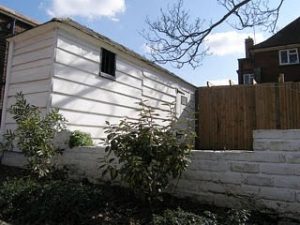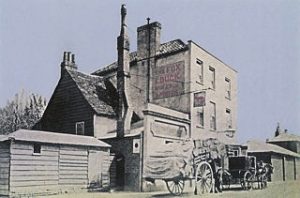The Original village watchman’s hut

The white-boarded, slate roofed building is the original village watchman’s hut and was erected in 1787. The small walled area in front of the lock-up was the corporation or old village pound. Here stray cattle were held until claimed by their owners. Originally the lock-up had opened directly onto the roadway with the pound behind it.
18th Century Vagrancy
Parish Councils introduced lock-ups in the late eighteenth century to deal with the increase in vagrancy and drunkenness and nearly every village in the country had its own lock-up. Beggars and vagrants probably assembled on a Sunday to pester the gentry as they attended church.
The Parish constable or watchman would be elected each year at the annual vestry meeting of the Parish Council. They were also known as Sergeants of the Night. The building housed the watchman with his musket, bayonet, pair of pistols, cartridge box, three pounds of grapeshot, powder flask, lantern and his greatcoat to keep him warm throughout the long winter nights.
Watchman History
In 1787 the watchman was paid 11 shillings a week to guard the village from 9 o’clock at night to 3 o’clock in the morning. He had orders to ‘stop all strangers of a suspicious appearance found in the Parish, or conveying articles in carts or otherwise at unseasonable hours and not being able to give a good account of themselves’. Highwaymen were frequently active on the Petersham Road.
In 1821 a Richard Wigley of Ham was employed as a watchman. He attempted to stop a horse and cart driven by a Robert Knight of Richmond. Knight was engaged in smuggling spirits at the time. Wigley shot Knight in the head and he died shortly after. The affair excited a great deal of interest and was reported in the Times Newspaper. Wigley was committed for murder and the case was heard at the Surrey Assizes at Kingston. Wigley was found guilty of manslaughter and sentenced to six months imprisonment.
The Metropolitan Police was formed in 1829 and by the late 1830’s the new police had taken over most of the outer areas of London. As new police stations were built lock-ups became redundant and most were pulled down for development as they were on prime sites in town centres. It is thought that the Petersham lock-up survived as the Council used it as a storeroom for their tools.

In 1940 the old timber constructed Fox and Duck public house, which probably dated from about 1700 was demolished. Originally it was called the “Horse and Groom” and served as a posting house on the London to Guildford stagecoach route. The public house was rebuilt further back from the road, in a mock Georgian style.
Fortunately the lock-up, still intact, was moved back to just in front of the building line of the archway of the Forge Garage. The pound area was moved from the back to the front area of the lock-up.
In 1955, the lock-up survived another reprieve. Some Petersham villagers felt that it should be demolished on account of its dilapidated state. Fortunately the Ancient Monuments Committee stepped in and decided that it was worth preserving. Surrey County Council agreed to repairs costing £40. Since that time the lock-up has received minor repairs. It is a listed building, Grade 2 and in 2004 thanks to the representations made by the Environment Trust for Richmond, the lock-up appeared on the English Heritage list of important buildings at risk (the BAR register).
Protecting and restoring buildings at risk
The Environment Trust for Richmond upon Thames is a registered charity working to protect and restore buildings and landscapes at risk in the Borough of Richmond. For over ten years the Trust has kept a watch on the Lock-up and worked with Ham and Petersham Association to persuade the Council to carry out a restoration. The Trust produced a set of drawings and more recently a specification for the major repair works and the tidying and planting of the surrounding area, and has researched potential funding from charitable trusts. Since the redevelopment of the Old Forge and the Section 106 monies becoming available, the restoration has finally started and should be completed by autumn 2007. It is hoped that residents of Petersham will continue to monitor the building’s condition and to maintain the pound area.
Ham and Petersham Association 2007. With thanks to John Shorrocks, Scotland Yard.